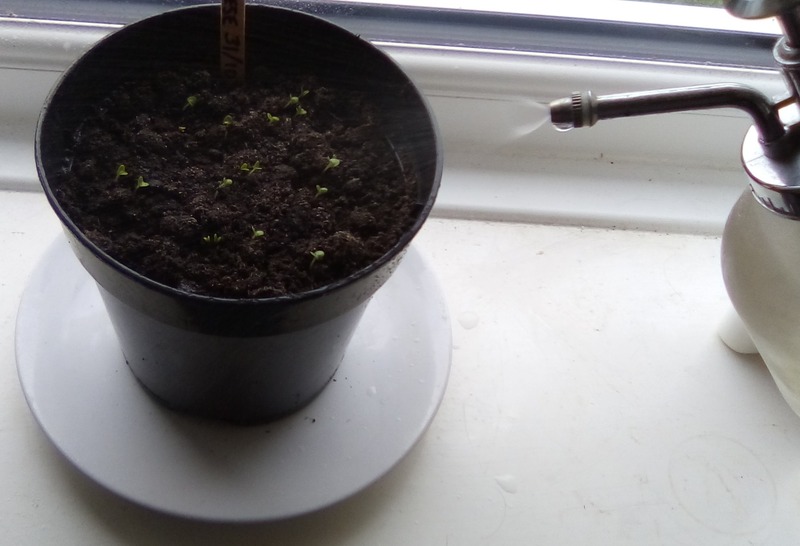Basil, the king of cooking herbs, is a firm favourite in my kitchen. Torn into sauces, soups and sandwiches – yum. Scattered over pizzas, or blitzed into pesto – amazing.
As a Mediterranean heat lover, basil oozes summer, especially freshly picked. So on a drizzly October day I got to wondering.

If I could grow basil indoors over winter, I could enjoy that fragrant, just-picked taste of summer all year round. But would it grow?
I Googled, but found contradictory information and frankly, lots of waffle. So I tried sowing some seed myself.
Growing winter basil indoors from seed
On Halloween, I sowed Genovese basil seeds into general purpose compost indoors. Sat on my sunniest windowsill (west facing, with sunlight from afternoon to sunset), this is how they looked at 8 weeks:

Not very impressive, are they? My poor sunlight-hungry seedlings only reached about an inch tall. At which point, I cut my losses and abandoned them.
In spring or summer, basil is ready to harvest in about 4 weeks. My winter sown basil was still teeny (basically microgreens) after 2 months!
Basil needs bright sunlight – and lots of it
As you see from my stalled seedlings, growing basil indoors from seed doesn’t work well in winter (at least without grow lights).
Basil loves bright direct sunlight, around 6-8 hours a day, and seedlings are especially light hungry.
With fewer daylight hours and less intense sunlight in winter, seedlings grow too slowly to really get going.
If you’ve a sun-drenched south-facing windowsill you may have more luck, so it’s worth a try. Otherwise, your winter sown basil will probably struggle (like mine).
Most reliable way to grow winter basil indoors?
Use an established plant
Rather than starting basil from seed, you’re better off with a pre-grown plant you can keep going. Harvest it sparingly and it should keep you in fresh basil right through the chilly months.
Shop-bought is quickest and easiest. You needn’t go to a garden centre, one from the supermarket is fine. Pop it on a saucer or into a pot cover to collect any water overspill.
Or if you’re patient, plan ahead and sow seed in spring to give a homegrown plant time to establish. Sprinkle a few seeds into a small pot of compost, add more compost to cover (half an inch or so), and keep soil evenly moist as the seedlings grow.

Otherwise, if you want to raise vigorous, healthy basil from seed in winter, it’ll need around 16 hours a day under a grow light.
Keep indoor basil growing right through winter
Once it’s established, helping basil to survive winter indoors isn’t too difficult. The plant will grow more slowly in winter, but with adequate heat and light should still produce new leaves every few weeks.
Though basil is an annual, it can live for two or even three years if you look after it. Here’s how to keep it happy in winter (and all year round):
1. Pick a bright enough location
A kitchen windowsill is the most convenient spot for your basil. You can reach out and snip off fresh leaves when you’re cooking.
But if your kitchen doesn’t get much light, pick your sunniest window instead. Basil plants are sun worshippers and need at least 6 hours a day of direct sunlight. Without enough, they grow tall and leggy rather than bushing out.
If nowhere in your home has sufficient natural light, you can use a grow light. Keep it under the light for 12-14 hours a day, leaving 4 inches above the plant to stop leaves scorching.
2. Give it consistent heat
Basil is happiest at around 60-85°F during the day, and 50-70°F at night. This shouldn’t be a problem indoors with the winter heating on.
The plant will do best at a consistent temperature, without too much fluctuation. Avoid keeping it near a heater or in a draughty spot like by an air conditioning vent.
3. Keep soil moist but not saturated
Water the plant from above or let it soak up water from the saucer or pot cover. It won’t mind, as long as you keep the soil consistently moist.
Don’t let it sit in sodden, waterlogged soil as that can lead to root rot. Do the finger test and only water when the top inch of compost starts to feel dry.
Water well, but try to avoid wetting the leaves as it can cause fungal diseases. Stop watering when excess water starts pouring from the pot’s drainage holes.
If you’re forgetful, a self-watering pot (or gadget like this funky little tap) is a good investment. It won’t break the bank and, if your growing efforts pay off, will eventually pay for itself in reduced grocery bills!
4. Boost humidity around the plant
Though it’s a heat lover, basil doesn’t like dry air and prefers moderate to high humidity (40-70%). That can be an issue in winter as most of us ramp up the central heating.
Mist around the plant lightly with a spray bottle every morning. Otherwise, stand it on a tray of pebbles filled with water to just below the top of the pebbles. As water evaporates, it’ll create a humid microclimate around the plant.
5. Feed it with nitrogen
Choose a nitrogen-rich liquid feed to stimulate green leafy growth. Feed the plant every 2-4 weeks, consulting the directions on the packaging. Avoid the temptation to overfeed as it can cause leaf burn.
Alternatively, slow-release fertilisers are nice and easy. You can incorporate them into the potting soil and the plant will take up nutrients as needed.
6. Give it the chop
Regularly pruning your basil will stimulate new growth, and luckily you’ll be doing this anyway to use the leaves.
Harvest larger leaves first, cutting just above a leaf node. This will encourage the plant to bush out rather than grow leggy. Snip off and discard any damaged, dry or discoloured leaves too.
7. Be vigilant with pests
Keep an eye out for bugs and use an organic insecticide as soon as you spot any. Basil can fall prey to spider mites, aphids and other pests, and these can weaken the plant if left to take hold.
Before you go…
If you fancy adding another crop to your indoor harvest, why not have a go at growing radishes indoors too. They’re nice and easy!

